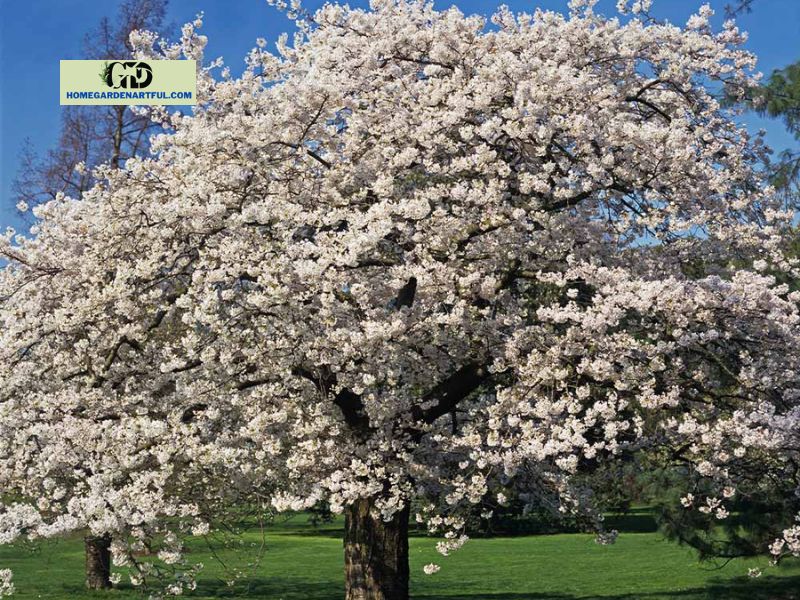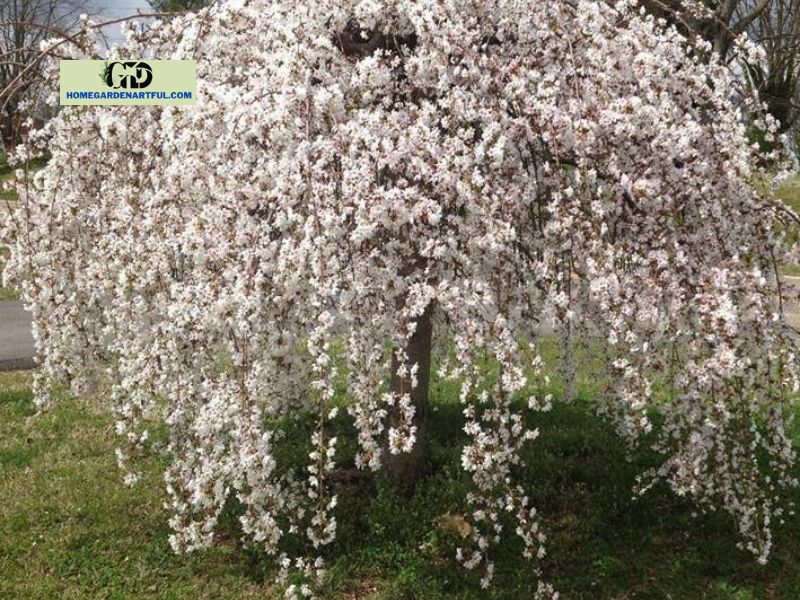Weeping Yoshino Cherry Trees, also known as Japanese flowering cherry trees, are notable at cherry blossom festivals all over the world for their springtime blooms of magnificent bare branches covered in almond-scented, pale pink petals. Although their tiny berries are unpalatable to humans, they draw birds and butterflies to your garden. Yoshino cherry trees are heat-tolerant and develop in a distinctive, exotic shape. Discover at homegardenartful.com!
Weeping Yoshino Cherry Tree information

The botanical names for this tree, commonly known as the weeping Higan cherry tree, are Prunus subhirtella and Prunus pendula. One of the earliest types of cherry blossom trees to be imported to the U.S. and Europe in the middle to late nineteenth century, it has its origins in Japan.
Because they bloom in the spring, cherry blossom trees represent rebirth in Japanese culture. The transient quality of the blossoms, however, also serves as a metaphor for life’s limited duration. Giving a cherry tree as a present is said to bring good fortune in Western culture.
Given that it can live for up to 30 to 40 years, this perennial tree with weeping branches is regarded as a long-term landscape investment. The tiny, one-inch-diameter flowers come in a variety of colors, from white to pinkish-white and pink.
These trees will bloom in the early spring because they are deciduous. Green greenery takes its place once the blossoms fade.
Eventually, the tree’s leaves will turn golden in the fall, and by the next winter, they will be completely gone. These trees don’t produce edible berries, but they do supply food for animals like birds, squirrels, and even deer.
Care for Weeping Yoshino Cherry Tree

Although there are some fundamental requirements, caring for these weeping trees is rather simple. The best-growing conditions for weeping cherry trees are described in the following paragraphs.
Sun and Temperature
Weeping cherry trees, both standard and dwarf types, do best in full-sun locations with at least 6 to 8 hours of daily direct sunshine. Although they can withstand some shade, they might not bloom as abundantly in this environment.
In USDA hardiness zones 5 to 10, the majority of weeping cherry tree cultivars can thrive. Check your particular variety, though, as some are not suitable for hardiness zones 5 or below.
These trees require a specific number of “chill hours” in order to break dormancy and bloom in the spring, just like cherry trees that bear edible fruit. The majority of types require 700–900 hours below 45 degrees Fahrenheit to do this.
Humidity and water
When you first plant your conventional or dwarf Weeping Yoshino Cherry Tree, water is crucial to ensure the root ball gets established. Young trees require extra care, although mature weeping cherry trees are more likely to endure dry spells.
A layer of mulch placed around the tree upon planting may be helpful to aid with moisture retention. Leave a 3 to 4-inch mulch-free area around the base of the trunk while mulching. The best time to water trees is early in the day before the heat of the day arrives. Until the tree gets established, water it frequently.
If you live in a dry area, adding drip irrigation might be a good idea as a “set it and forget it” way to ensure that your tree receives adequate watering for the duration of its life. If it rains frequently where you live, you don’t need to do this.
High humidity is not good for weeping cherry trees. Poor circulation and high humidity might contribute to fungus problems.
Soil
As long as the soil has proper drainage, weeping cherry trees don’t have a particular preference for soil types. They will, however, prosper in a pH-neutral, loose, loamy soil type.
Problems with rot might result from too much water around the root ball. Avoid placing these trees near a downspout or in a low-lying region of the landscape for this reason.
When planting, it’s also crucial to press down the soil around the roots to remove any air pockets. This facilitates the ease with which newly planted tree roots can penetrate the surrounding soil.
Fertilization
Weeping cherry trees don’t require additional nutrients in order to put on their magnificent flowers, which makes growing them reasonably hassle-free.
When you cultivate weeping cherry tree varieties, a healthy amount of organic compost and organic material in the planting hole at the time of transplant will be sufficient.
At the start of each growth season, side-dress with more organic compost if you want to give your tree a boost.
Pruning

Ordinary trimming is not necessary for your weeping Yoshino Cherry Tree, ordinary or dwarf. However, pruning to allow for proper airflow and to remove diseased as well as dead branches can improve the general health of the tree and its canopy.
It is advised that growers avoid removing branches with significant drooping. It is a weeping tree, after all! Remove straight-growing branches as well because they won’t weep and will instead keep growing higher.
You might also want to think about planting it far enough away from other trees and buildings so that it can fully extend its canopy without needing to be pruned to keep its growth and shape under control. Leave outer drooping branches alone and just prune to make the canopy more open for good airflow.
If your weeping cherry tree becomes afflicted with a disease, you could also want to prune it by removing the offending limbs. When the tree first blooms or while it is sporting its pink flowers, avoid cutting it. The greatest time to prune a tree is when it is dormant in the winter.
Propagation
Weeping Yoshino Cherry Trees can be produced from seed, much like the majority of blooming cherry trees. However, this procedure takes the longest to complete. Weeping cherry seed germination might take four months to a year.
Additionally, they can grow from cuttings. In the summer, cuttings can be obtained from younger wood. Pick a branch with a minimum of 2-4 nodes and leaves.
Use conventional techniques for cutting propagation, such as immersing it in rooting hormone and planting it in soil. Water them frequently until roots appear. You have the option of planting your cutting in the ground or in a pot.
However, it takes some time for this procedure to produce a fully-grown tree. However, grafted trees make up the majority of weeping cherry trees that are sold commercially.
The weepy branch, or scion, of weeping cherry trees, is frequently grafted onto the rootstock of a typical single trunk to produce an umbrella-like shape.
Conclusion
One of the most well-known ornamental cherry trees in the world today is the Weeping Yoshino Cherry Tree. It has a beautiful pendulous form and is renowned for being among the earliest cherry trees to blossom. The flowers on this tree have a lovely almond aroma and adorn the environment.


